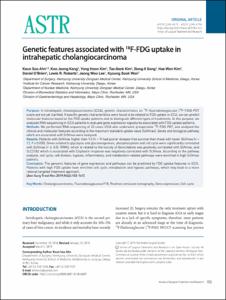Genetic features associated with 18F-FDG uptake in intrahepatic cholangiocarcinoma
- Keimyung Author(s)
- Ahn, Keun Soo; Kang, Koo Jeong; Kim, Yong Hoon; Kim, Tae Seok; Song, Bong Il; Kim, Hae Won; Won, Kyoung Sook
- Journal Title
- Annals of Surgical Treatment and Research
- Issued Date
- 2019
- Volume
- 96
- Issue
- 4
- Keyword
- Cholangiocarcinoma; Fluorodeoxyglucose F18; Positron-emission tomography; Gene expression; Cell cycle
- Abstract
- Purpose:
In intrahepatic cholangiocarcinoma (iCCA), genetic characteristics on 18F-fluorodeoxyglucose (18F-FDG)-PET scans are not yet clarified. If specific genetic characteristics were found to be related to FDG uptake in iCCA, we can predict molecular features based on the FDG uptake patterns and to distinguish different types of treatments. In this purpose, we analyzed RNA sequencing in iCCA patients to evaluate gene expression signatures associated with FDG uptake patterns.
Methods:
We performed RNA sequencing of 22 cases iCCA who underwent preoperative 18F-FDG-PET, and analyzed the clinical and molecular features according to the maximum standard uptake value (SUVmax). Genes and biological pathway which are associated with SUVmax were analyzed.
Results:
Patients with SUVmax higher than 9.0 (n = 9) had poorer disease-free survival than those with lower SUVmax (n = 13, P = 0.035). Genes related to glycolysis and gluconeogenesis, phosphorylation and cell cycle were significantly correlated with SUVmax (r ≥ 0.5). RRM2, which is related to the toxicity of Gemcitabine was positively correlated with SUVmax, and SLC27A2 which is associated with Cisplastin response was negatively correlated with SUVmax. According to the pathway analysis, cell cycle, cell division, hypoxia, inflammatory, and metabolism-related pathways were enriched in high SUVmax patients.
Conclusion:
The genomic features of gene expression and pathways can be predicted by FDG uptake features in iCCA. Patients with high FDG uptake have enriched cell cycle, metabolism and hypoxic pathways, which may lead to a more rational targeted treatment approach.
- Publisher
- School of Medicine (의과대학)
- Citation
- Keun Soo Ahn et al. (2019). Genetic features associated with 18F-FDG uptake in intrahepatic cholangiocarcinoma. Annals of Surgical Treatment and Research, 96(4), 153–161. doi: 10.4174/astr.2019.96.4.153
- Type
- Article
- ISSN
- 2288-6796
- Source
- https://www.astr.or.kr/DOIx.php?id=10.4174/astr.2019.96.4.153
- Appears in Collections:
- 1. School of Medicine (의과대학) > Dept. of Nuclear Medicine (핵의학)
1. School of Medicine (의과대학) > Dept. of Surgery (외과학)
- 파일 목록
-
-
Download
 oak-2019-0101.pdf
기타 데이터 / 705.42 kB / Adobe PDF
oak-2019-0101.pdf
기타 데이터 / 705.42 kB / Adobe PDF
-
Items in Repository are protected by copyright, with all rights reserved, unless otherwise indicated.